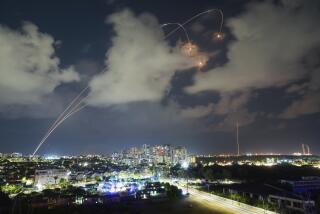Missile Plan Doesn’t Fly
Not since Ronald Reagan’s years in the White House has an administration been so enthusiastic about missile defense. The Clinton and first Bush administrations harbored legitimate doubts about the effectiveness of a shield against incoming intercontinental missiles. But they kept providing billions of dollars for testing, as has the current Bush administration.
This week, the administration decided not just to keep testing, but to deploy. Under its plan, interceptor stations would be established at an Alaskan facility and at Vandenberg Air Force Base in 2004 to shoot missiles at incoming missiles -- firing a “bullet at a bullet.” Three of the last eight tests have been outright failures, and countermeasures like decoy missiles would no doubt make it even less accurate in the real world.
Deployment would be expensive. The cost of continued testing is $8 billion a year, already approved by Congress. To build the new facilities would require at least an additional $1.5 billion over two years. For that money, Americans would get a system that Defense Secretary Donald H. Rumsfeld said Tuesday is “better than nothing.”
Along with land-based antimissile systems, the Pentagon said it would put smaller interceptors on several Navy ships and would upgrade the Patriot missile system to counter shorter-range attack missiles. They are just the start of a multilayered system that, ideally, would someday be able to destroy missiles shortly after launch, in mid-flight or after reentry to the Earth’s atmosphere. That’s an ambitious, costly and speculative plan. For now, the money would be better spent on more immediate threats.
Last January, U.S. intelligence agencies concluded that the nation was more likely to be attacked in the next 10 years by terrorists with chemical, biological or nuclear weapons than by a hostile nation firing intercontinental missiles.
Since then, granted, North Korea has acknowledged a continuing nuclear weapons development program. It also may end its voluntary moratorium on flight-testing new missiles. But the defense that worked for the United States during the Cold War still stands: the knowledge that any country attacking the U.S. faces devastating retaliation.
Start with security at the nation’s ports, including those at Long Beach and Los Angeles. After 9/11, the two sought $70 million in federal grants for security, but only got about $6 million. Money spent at the ports would not chase phantoms, but protect against real threats.
More to Read
Sign up for Essential California
The most important California stories and recommendations in your inbox every morning.
You may occasionally receive promotional content from the Los Angeles Times.










